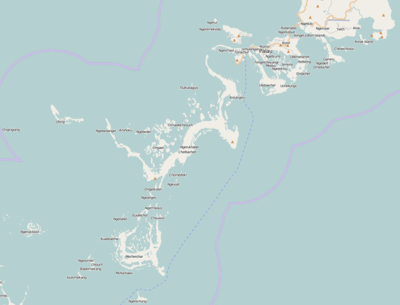Geography of Palau



The Republic of Palau consists of eight principal islands and more than 250 smaller ones lying roughly 500 miles southeast of the Philippines. The islands of Palau constitute part of the Caroline Islands chain.
Location: Oceania, group of islands in the North Pacific Ocean, southeast of the Philippines
Geographic coordinates: 7°30′N 134°30′E / 7.500°N 134.500°E
Map references: Oceania
Area:
total:
459 km²
land:
459 km²
water:
0 km²
Area - comparative: slightly more than 2.5 times the size of Washington, DC
Land boundaries: 0 km
Coastline: 1,519 km
Maritime claims:
territorial sea:
3 nm
exclusive fishing zone:
200 nm
Climate: tropical; hot and humid; wet season May to November
Terrain: varying geologically from the high, mountainous main island of Babeldaob to low, coral islands usually fringed by large barrier reefs
Elevation extremes:
lowest point:
Pacific Ocean 0 m
highest point:
Mount Ngerchelchauus 242 m (on Babeldaob)
Natural resources: forests, minerals (especially gold), marine products, deep-seabed minerals
Land use:
arable land:
2.17%
permanent crops:
4.35%
other:
93.48% (2011)
Irrigated land: NA km²
Natural hazards: typhoons (June to December)
Environment - current issues: inadequate facilities for disposal of solid waste; threats to the marine ecosystem from sand and coral dredging, illegal fishing practices, and overfishing
Environment - international agreements:
party to:
Biodiversity, Climate Change, Climate Change-Kyoto Protocol, Desertification, Law of the Sea
signed, but not ratified:
none of the selected agreements
Geography - note: westernmost archipelago in the Caroline chain, consists of six island groups totaling more than 300 islands, includes World War II battleground of Peleliu and world-famous rock islands
Extreme points
This is a list of the extreme points of Palau, the points that are farther north, south, east or west than any other location.
- Northernmost point – Ngaruangel Reef, Kayangel state*
- Easternmost point – Kayangel islet, Kayangel state
- Southernmost point – Round Rock, Helen Reef, Hatohobei state
- Westernmost point - Tobi Island, Hatohobei state
- *Note: if submerged reefs are included then Velasco reef is Palau's northern-most point
- See also : Palau
External links
| ||||||||||||||